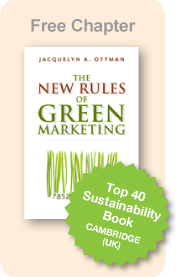Jacquie Ottman's
Green Marketing Blog
Eco-Logos: A Double-Edged Sword?
October 22, 2008 by Jacquelyn Ottman
Eco-logos are all the rage - but how valuable are they as a green marketing tool? Are there some hidden risks that warrant a second look? Let's consider the three ingredients of an effective marketing logo - green or otherwise - and their implications for the savvy eco-marketer.
Here are the three factors at play:
1. Recognizability. Eco-logos can reinforce green messages, a welcome benefit for sure. But of the myriad eco-logos on the market, only a few are known to consumers. They consist of the, chasing arrows recycling logo, the Energy Star seal of energy efficiency, USDA Organic logo, and TransFair FairTrade certification; after that recognition drops off significantly.
2. Credibility. The more trusted logos are granted by an independent, disinterested third party. For example, logos promulgated by government organizations like EPA and USDA make the cut. Same goes for the nonprofit Forest Stewardship Council's FSC certification for sustainably harvested wood, which tends to be better received than the SFI certification put forth by the Sustainable Forestry Initiative, an industry trade group.
3. Comparability. The carbon labeling system described in this article from Ethical Corporation magazine is provocative for sure -- wouldn't it be great if all products came with the carbon equivalent of an environmental nutrition label! But standards don't exist for measuring a product's carbon footprint and, until they do, any product offering one can't adequately be measured against its peers. Again, grounds for confusion.
Businesses that create their own eco-logos might be doing so at their risk. S.C. Johnson's‚ Greenlist logo, announced last week, might in the short term bolster a product's green image, but could one day be taken to task by government, NGOs, or the media for failing to include one or all of these three ingredients. For example, critics might point out that manufacturer-sponsored logos may unintentionally mislead consumers that the "certification" comes from an independent third party, rather than the manufacturer or retailer looking to sell product. Further, products with manufacturer-sponsored green logos have an unfair advantage over products that don't carry a similar seal -- consumers might infer that competitors' products failed to make the grade.
Until things shake out, manufacturers looking to reinforce green bona fides with eco-logos must tread carefully. Specifically:
- Use well-recognized certifications from trusted third parties.
- Ensure that consumers understand that your eco-logo is based on criteria developed by the manufacturer itself, not an independent verifier.
- Use transparent processes for measuring environmental footprint.
- Encourage use of the logo among other players within your industry.
The jury is still out on eco-logos as an effective marketing tool, but as consumers get increasingly savvy on environmental issues and impacts, you'd do well to make sure that, at the very least, they won't work against you.
Click here to join our mailing list.



 ShareThis
ShareThis

